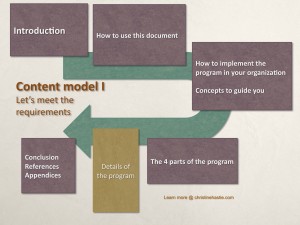Why do we try to reinvent the wheel? The world is full of examples of how information can be organized. Pick a content model. Any model!
Well, you’re right. Not just any model will do. You want the one that fits your content best and helps your team manage the work. That’s why knowing the requirements and expectations for the content—from Collaborative Writing Law 4 and Law 6—is so important. If you can’t find a ready-made model for the content, you will have to develop one.
Your collaborative energy will really be put to the test now! But you will love seeing the smile on everyone’s face when they see the container into which they can pop all their data and content. For writers and content specialists who master the skill of developing them, content models offer huge advantages every time they are used.

Content model developed for a document that describes a program that organizations can use and adapt to their needs. In the early stages of the project, not too much information appears in each section. It is gradually filled in as the information becomes available.
A content model, in the simplest terms, is an outline or structure. In this sample project, the subject matter experts were reluctant to even start preparing the document. They wanted to make a contribution to their field, but did not have time or energy to take on the burden of reworking their complex and specific material for other organizations who wanted to learn how to develop it.
Once everyone agrees on the requirements, your can establish a simple structure for adding content. Here the requirements were to simplify all the content and only include the most general aspects to:
- Introduce the topic
- Show how this document will help the user
- Describe how a program like this one can be implemented
- List some of the key concepts
- Give an overview of the program with more details for the specialists in each organization that will deliver the program
- Provide a conclusion with references
This is a shell. It can hold more detail, but notice how, right off the bat, there are indications that certain tools will be needed. The requirement to list some key concepts means that some definitions will be needed. As Ricky Ricardo used to say, “You’ve got some splainin’ to do Lucy!”
The experts can guide the writing team on knowing what the difference is between what is essential to the program, what is essential for the document, and what is essential to acknowledge about the foundation for the program. The outline describes a program of 4 parts so there is an easy way to structure the details of the program.
Developing an outline can be one of the most detested tasks. With a content model, the outline is already lying in front of everyone in plain view. Pour in the content. Discuss the requirements. Reach an understanding on what is needed and what would be nice to have if there is time. Chip away all the unnecessary stuff, leaving only the essentials, and you will have the foundation for a successful document.
Be sure to check out all 10 Laws of Collaborative Writing.
Featured image of potter’s wheel by Keepps via Photo pin





